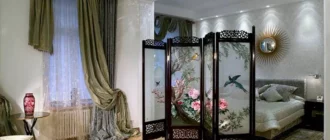
Expressionism in the interior is one of the most lively, energetic and at the same time exotic interior trends. It is often preferred by young people they choose it for its brightness, lack of clear canons, freedom and dynamics, which the young like so much.
Expressionism in the interior is very emotional, perhaps even somewhat theatrical. In the most exaggerated manifestations, he can be aggressive and able to shock an unprepared guest. Perhaps this is how the house of Salvador Dali or Wassily Kandinsky could look like. And every visitor in such a house feels like a guest at the most exciting performance in his life.


The main characteristics and features of expressionism in the interior
Expressionism as a style in the interior is fully consistent with its name. He is a feeling, mood, optimism, lightness and play, color and light. The direction resembles avant-gardism in that it breaks all stereotypes. But, unlike the latter, expressionism is softer, more harmonious, more romantic and more comfortable. To create such a refreshing, emotional and creative environment, you need an impeccable sense of style. And knowing some rules.
What you need to consider before creating an interior in the style of expressionism:
Architecture. This style is characterized by play with space, dynamics. Restrained canonical forms coexist with distorted or deliberately exaggerated ones up to the grotesque. The most important thing is diversity, which works on the general emotional background. No typical armchairs lined up on a ruler and identical, adjusted to the millimeter, window openings. Complex multi-tiered ceilings, wide rectangular or square windows, oval doorways and round wall niches, the proximity of simple geometry to complex “a la Gaudi” this is all about expressionism. Complete freedom of creativity.


Materials. Here, too, there is plenty to choose from. No canons. Any kind of textiles, plastic, wood, glass, stone, paper, ceramics, their imitations are appropriate. There is no clear link to the naturalness of materials or its absence. The main rule they should be smooth, visually light complex, heavy textures are out of place. In addition, you need to remember that gloss visually reduces the cost of almost everything. In a noble expressive interior, it must be used pointwise or completely abandoned.
Color solutions.
The interior in the style of expressionism is very picturesque. Both bright (except acidic) and restrained shades are welcome. It is important not to be too zealous: combinations should be harmonious, and it is better to avoid heavy, deep and dark colors in the palette or use them sparingly to arrange contrasting shades.
Finishing. Expressionism is about creativity. An “expressive” setting involves neutral wall decoration, which will become the backdrop for the rest of the space. They can be painted, pasted over with fabric, wallpaper, use other materials. When decorating walls and floors, preference is given to matte textures. But the ceiling may well be glossy or mirrored.
Furniture. Here, too, a flight of fancy is welcome. Wicker or heavy, monumental sofas can coexist with openwork tables, hanging cocoon chairs and “Scandinavian” chairs. It is important to observe proportions, the rules of harmony. It is inappropriate to clutter up the space with furniture, so it is better to install storage systems in niches.



Textile.
Textiles are welcome in the “expressive” interior. If only it wasn’t too much. Sofa cushions with African ornaments, a carpet with an abstract pattern, thick furniture upholstery, tapestry paintings all this is appropriate. But it is better to leave the windows open or install light blinds on them. In textile elements, “decorations” are not welcome rich draperies, flounces, laces and the like. The simpler the better.
Decor. The main requirement for decor is that it should not visually clutter up the space. Expressionism is about lightness, dynamism, freshness and mood. Paintings and reproductions in the same style, small trinkets, unusual vases, living plants are appropriate.
Light. Bright and picturesque expressionism is a story about the sun. The spacious environment requires a maximum of natural light, which is only emphasized by artificial light. Hidden light sources with multiple use cases are needed.


The history of expressionism in the interior
Expressionism in the interior is a relatively new phenomenon. The style appeared at the turn of the 19th and 20th centuries (the so-called era of modernism), when the expressionists, artists, writers, musicians, entered the stage and revolutionized it. His main idea is that art should not reflect reality, it can only express the emotions of the author of the work.


In Europe of those years, it was not very joyful, and therefore, from the high spheres, bright and cheerful expressionism flowed into everyday life. In 1921, the Einstein Tower was built, which became a model of this style in architecture. And then the expansion of the range of materials and textures contributed to the appearance of lively and dynamic elements in the home environment. In the 50-60s. XX century style is firmly in vogue and remains there to this day.
Expressionism in the interior is the choice of the young and cheerful.
And age has almost nothing to do with it the state of mind is important. With proper design, an “expressive” house or apartment turns into a place of power, always ready to recharge its owners and their guests with energy and optimism.























